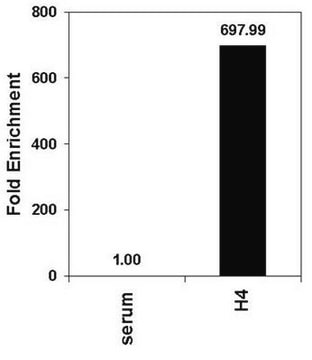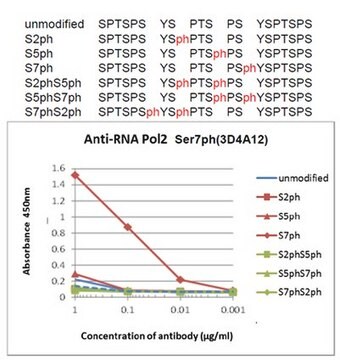17-620
ChIPAb+ RNA Pol II - ChIP Validated Antibody and Primer Set
from mouse
Sinonimo/i:
Chip Antibody and primer set, DNA-directed RNA polymerase II subunit RPB1, RNA polymerase II, RNA polymerase II ChIP
About This Item
Prodotti consigliati
Origine biologica
mouse
Livello qualitativo
Clone
monoclonal
Reattività contro le specie
rat, Saccharomyces cerevisiae, mouse, human
Produttore/marchio commerciale
ChIPAb+
Upstate®
tecniche
ChIP: suitable
immunofluorescence: suitable
immunoprecipitation (IP): suitable
Isotipo
IgG1
N° accesso NCBI
N° accesso UniProt
Condizioni di spedizione
dry ice
Descrizione generale
The ChIPAb+ RNA Pol II set includes the RNA Pol II antibody, the negative control antibody (mouse IgG), and qPCR primers flanking the human GAPDH promoter, yielding a 166 bp product. The RNA Pol II and negative control antibodies are supplied in a scalable "per ChIP" reaction size and can be used to functionally validate the precipitation of RNA Pol II associated chromatin.
Specificità
Immunogeno
Applicazioni
Epigenetics & Nuclear Function
Chromatin Biology
3T3 nuclear extract was resolved by electrophoresis, transferred to nitrocellulose and probed with anti-RNA polymerase II (0.1 μg/mL). Proteins were visualized using a goat anti-mouse secondary antibody conjugated to HRP and a chemiluminescence detection system (Please see figures).
Confezionamento
Qualità
Descrizione del bersaglio
Stato fisico
Normal Mouse IgG. One vial containing 25 ug of mouse IgG in 25 μL volume. Store at -20°C.
Control Primers p21. One vial containing 75 μL of 5 μM of each primer specific for a region of the human GAPDH promoter. Store at -20°C.
FOR: TAC TAG CGG TTT TAC GGG CG
REV: TCG AAC AGG AGG AGC AGA GAG
CGA
Stoccaggio e stabilità
Risultati analitici
Included negative control antibody mouse IgG and control primers specific for human GAPDH.
Note legali
Esclusione di responsabilità
Codice della classe di stoccaggio
10 - Combustible liquids
Certificati d'analisi (COA)
Cerca il Certificati d'analisi (COA) digitando il numero di lotto/batch corrispondente. I numeri di lotto o di batch sono stampati sull'etichetta dei prodotti dopo la parola ‘Lotto’ o ‘Batch’.
Possiedi già questo prodotto?
I documenti relativi ai prodotti acquistati recentemente sono disponibili nell’Archivio dei documenti.
Il team dei nostri ricercatori vanta grande esperienza in tutte le aree della ricerca quali Life Science, scienza dei materiali, sintesi chimica, cromatografia, discipline analitiche, ecc..
Contatta l'Assistenza Tecnica.








